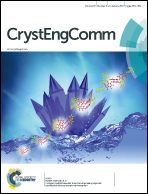Self-assembly of the tetrachlorido(oxalato)rhenate(iv) anion with protonated organic cations: X-ray structures and magnetic properties†
Abstract
Two novel ReIV compounds of formulae [H2bpy][ReIVCl4(ox)] (1) and [H3biim]2[ReIVCl4(ox)] (2) [H2bpy2+ = 4,4′-bipyridinium dication, H3biim+ = 2,2′-biimidazolium monocation, and ox2− = oxalate dianion] have been synthesised and magneto-structurally characterised. 1 crystallises in the monoclinic system with space group C2/c, and 2 crystallises in the triclinic system with space group P![[1 with combining macron]](https://www.rsc.org/images/entities/char_0031_0304.gif) . The ReIV ion in 1 and 2 is six-coordinate, bonded to four chloride ions and two oxalate-oxygen atoms in a distorted octahedral geometry. Short intermolecular ReIV–Cl⋯Cl–ReIV contacts, Cl⋯π type interactions and hydrogen bonds are present in the crystal lattice of both compounds, generating novel supramolecular structures based on the highly anisotropic [ReIVCl4(ox)]2− species. Examination of the magnetic properties of 1 and 2 reveals significant antiferromagnetic coupling between ReIV ions propagated primarily through the ReIV–Cl⋯Cl–ReIV interactions, as evidenced by the occurrence of maxima in the magnetic susceptibility at ca. 12 (1) and 17 K (2).
. The ReIV ion in 1 and 2 is six-coordinate, bonded to four chloride ions and two oxalate-oxygen atoms in a distorted octahedral geometry. Short intermolecular ReIV–Cl⋯Cl–ReIV contacts, Cl⋯π type interactions and hydrogen bonds are present in the crystal lattice of both compounds, generating novel supramolecular structures based on the highly anisotropic [ReIVCl4(ox)]2− species. Examination of the magnetic properties of 1 and 2 reveals significant antiferromagnetic coupling between ReIV ions propagated primarily through the ReIV–Cl⋯Cl–ReIV interactions, as evidenced by the occurrence of maxima in the magnetic susceptibility at ca. 12 (1) and 17 K (2).



 Please wait while we load your content...
Please wait while we load your content...